- Your gateway to the Maritime Knowledge!
- [email protected]
ROR situations and COLREGS application
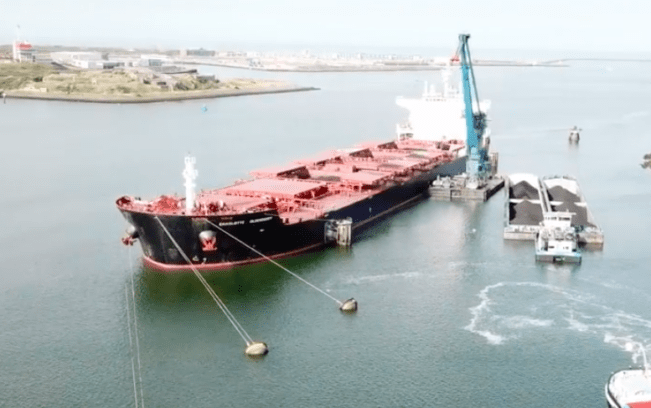
What is a Boat Note and where it is used?
April 1, 2020
What are Codes and Conventions, Treaty & Protocols
April 2, 2020In this topic we shall come across few interesting ROR situations and shall state the best possible actions within the purview of COLREGS (International Regulations for Prevention of Collision at Sea). These situations are commonly asked in the Nautical Examinations and also very much encountered at sea. I assume that you have a good understanding of COLREGS as it will help you to understand the situations better.
Before we begin kindly go through the following abbreviations which we will use in the topic –
OV: Own Vessel, which means the vessel which, supposedly, you are navigating
TV: Target Vessel. It is the vessel with whom the Risk of Collision may or may not exists
ROC: Risk of Collision , PD: Power Driven Vessel
RV:Restricted Visibility
FV: Fishing Vessel
CBD: Vessel Constrained by her Draft
RAM: Vessel Restricted in her ability to maneuver
NUC: Vessel Not Under Command
Situation No 1
Description: Own vessel Navigating in dense fog ahead, with Radar NOT operational.
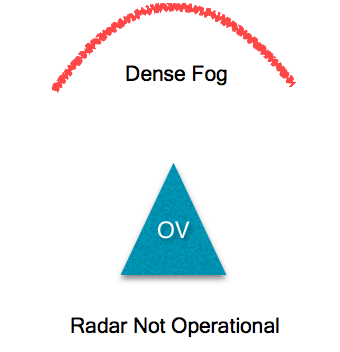
Action: As per the application scope of Rule No 2: Responsibility, the vessel can safely drop anchor (if in anchoring depths) and wait till the visibility improves. This is in light of good seamanship. Additionally, additional lookouts shall be posted, including sight and by hearing and frequency of sound signals shall be increased. Moreover, the deck lights (normally switched on during anchoring) will give an early indication to the other vessel of the own vessel’s presence.
If not in anchoring depths, the vessel shall proceed at slow speed with engines on maneuvering RPM and kept standby all times. (More discussion on this in Situation No 12:Restricted Visibility)
Situation No 2
Description: Own vessel navigating in a Narrow channel “upstream” , i.e. Tidal flow against the direction of the Own vessel. Target vessel approaching from ahead as shown.

Action: Own vessel shall wait for the Target Vessel to pass as OV is heading into the Tidal Stream and it will be much easier to handle OV (wrt steering etc). This, again is and example of good seamanship as required in accordance with Rule No 2: Responsibility.
Situation No 3
Description: Own vessel in head on situation with the Target Vessel. ROC exists. Shallow water on the starboard side.

Action: As per Rule No 2 “Responsibility” which permits to “make a departure from the rules in special circumstance to avoid immediate danger”, the OV is permitted to alter course to her Port Side. Note that this situation consists of both “special circumstances” and “immediate danger”.
Important Note on Vessel NUC
The following vessels are also considered to be NUC –
- Vessel with her Anchor down but not holding
- Vessel who is riding to her chains with anchor
- Sailing vessel unable to move due to lack of wind
Situation No 4: On Narrow Channels
Description: TV is a Vessel less than 20mtrs in length (or a Sailing /Fishing Vessel). She is head on with OV in a Narrow Channel.
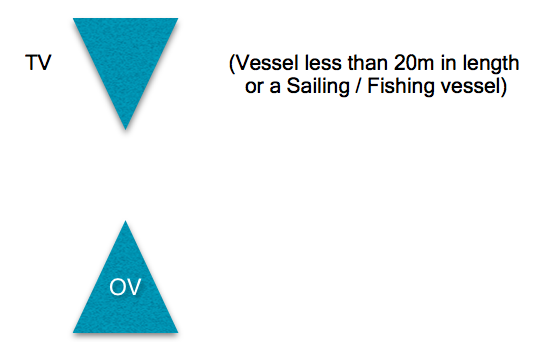
Action: OV in this situation is a Stand-On vessel and TV is a Give way vessel.
Here it is important to note the following points –
- Narrow Chanel Rule (Rule No 9) does not applies to Traffic Lanes of TSS (Rule 10 applies there
- Narrow channels can be crossed, so long that it does not impede the safe passage of the other vessel
- If the intentions of the TV is not clear, 5 Short Blasts on the ship’s whistle may be sounded.
Situation No 5: Application Scope of Rule 10 (Traffic Separation Schemes)
Following points are required to be kept in mind with respect to Rule 10
1. The other rules of COLREGS continue to apply even when the vessel in is in TSS
2. A vessel navigating inside an Inshore Traffic Zone, is NOT using the TSS
3. Separation zone in TSS can only be used by –
a. Vessel crossing TSS
b. Vessel engaged in Fishing
c. Vessel avoiding immediate danger
4. YG Signal: This signal means that “you are not complying with the TSS”
Situation No 6: Application Scope of Rule No 13 (Overtaking)
- A vessel is said to be overtaking when she is approaching the other vessel from >= 22.5 degrees abaft the beam. At night she is able to see only stern lights (and not side lights) of the other vessel.
- If there is any doubt to this, the situation is deemed to be overtaking.
- Alteration of course does not make an overtaking vessel a crossing vessel
- Rule 13 (Overtaking) supersedes Rule 18 (Responsibility between vessels)
- Overtaking in a Narrow Channel shall always be done with mutual agreement
- Interaction and Shallow water effects shall be kept in mind while overtaking in a narrow channel
Situation No 7: Application Scope of Rule No 14 (Head On situation)
- This rule applies to power driven vessels
- This rule requires BOTH vessels to take action
- The term ‘Head On’ means, technically +/- 6degrees to the reciprocal course.
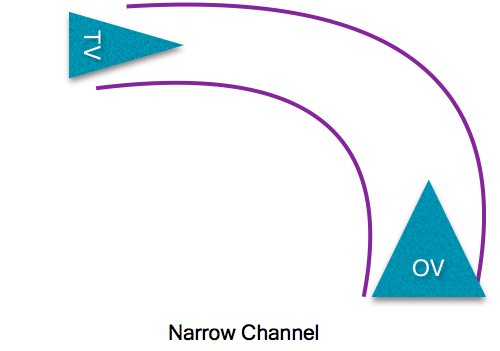
Situation No 8: Narrow Channel (figure above)
Description: OV navigating through a Narrow Channel. TV position as shown. Both vessel navigating inside a Narrow Channel
Action: This is NOT a Crossing situation. Both vessels have the responsibilities to keep clear from each other.
Situation No 9: Crossing Situation – Scope of Application
Following points to be remembered in Crossing Situation (Rule No 15)
- Rule No 18 (Responsibilities between vessel) has a higher precedence over Rule No 15 (Crossing Situation)
- Where applicable the Wake-up Signals shall be used and preferably over 2 miles.
- Description: Target Vessel (NUC or RAM or FV) and OV (Power Driven) as shown below an ROC exists
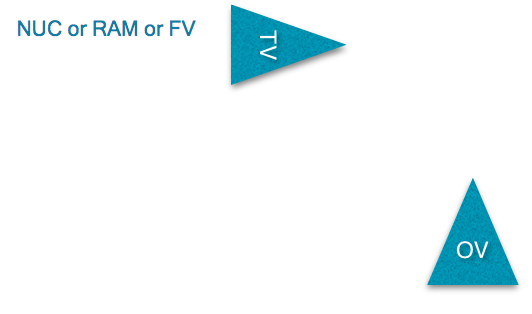
Action: Avoid crossing ahead of the Target vessel. ‘Wake-up’ signal (5 short blasts on the ship’s whistle) to be given to seek attention of the Target Vessel. Pass by her stern after altering your Course hard over to starboard. The Own Vessel is the Give-way vessel and Target Vessel is the Stand-On vessel.
Situation No 10 : CBD Vessel crossing
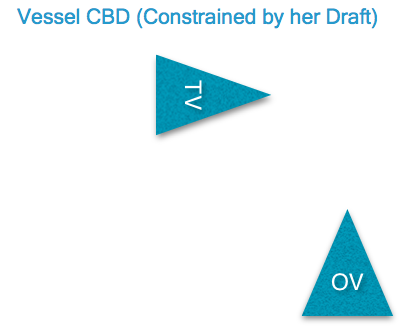
Description: Own vessel (Power Driven) involved in a crossing situation with vessel Constrained by her Draught (Target Vessel) as shown above. ROC exists.
Action: Very important to note that in this situation OV is the Stand-On vessel and TV (CBD) is the Give-Way vessel. ‘Wake-up signal’ shall be given (5 short blasts on ship’s whistle). If no action taken by the TV, OV to give wide alteration to Starboard and pass by stern of the TV.
Situation No 11: Responsibilities between Vessel – Application Scope
Following is the degree of responsibilities between the different types of vessel
- NUC, RAM, FV, SV has precedence over PD Vessel [NUC,RAM,FV,SV > PD]
- NUC, RAM, FV has precedence over SV [ NUC, RAM, FV > SV ]
- NUC, RAM has precedence over FV [ NUC, RAM > FV ]
- CBD vessel has precedence over FV, SV and PD , BUT CBD vessel has to navigate with caution
- NUC, CBD, RAM, FV, SV, PD has precedence over Seaplane and WIG craft
- Rule 13 (Overtaking) has higher precedence over Rule 18 (Responsibilities between Vessels)
- When both vessels are hampered, then both vessel shall take action to avoid collision. Alteration of course in such cases shall be preferably to starboard
Situation No 12: Restricted Visibility – Application Scope
Restricted Visibility is one of the most important rules of COLREGS. Its importance lies in the fact that many decisions of the courts have come against the vessel where the Master and/or OOW were confident that they have taken action as specified by the Rule 19. Therefore, OOW shall be well versed with the action he shall take in order to avoid Risk of Collision in cases of RV. I will break down the Restricted Visibility Rule into 2 parts stating in a simplified manner, that what probable actions shall be taken and what actions shall not be taken. Note that this explanation is strictly in accordance with the Rule 19, which applies to vessel navigating in or near areas of Restricted Visibility.
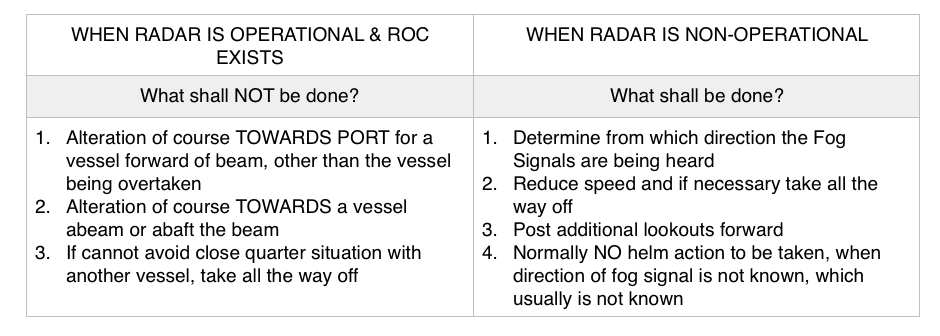
Restricted Visibility
On the basis of above key points, many situations can be derived and answered accordingly. I am not explaining any situation here. However, if you have any doubt with any ROR situation you can put it in the comment box below and I will try answering them.
Follow us on various other platforms – Twitter: https://twitter.com/funnel2tunnel Facebook: https://www.facebook.com/funnel2tunnel/ Instagram: https://www.instagram.com/funnel2tunnel/ Linkedin: https://www.linkedin.com/company/funnel2tunnel/
Watch interesting youtube videos here.
Wish you fair seas and Bonn Voyage !



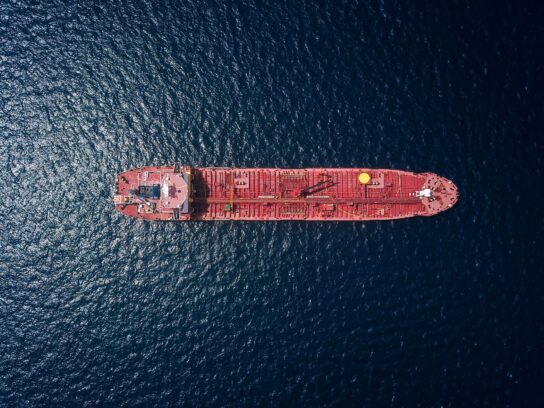
2 Comments
https://waterfallmagazine.com
Do you mind if I quote a few of your posts as long
as I provide credit and sources back to your blog?
My blog site is in the exact same niche as yours and my visitors would definitely
benefit from some of the information you provide here. Please let
me know if this okay with you. Many thanks!
Dear Lisa,
Glad to connect with you.
We would be happy if our work is quoted at different platforms.
Please mention the credits & source it to our website address.
Kindly share the link with us for the same.
Also, do let us know if you take reference of our work in the near future as well.
Thanks and much regards
Team funnel2tunnel.com